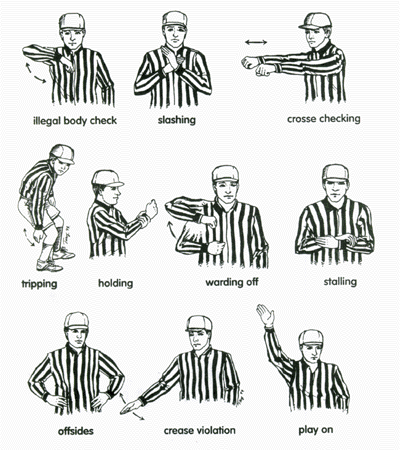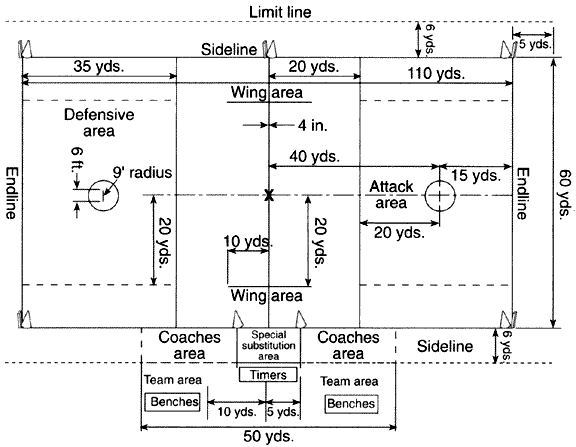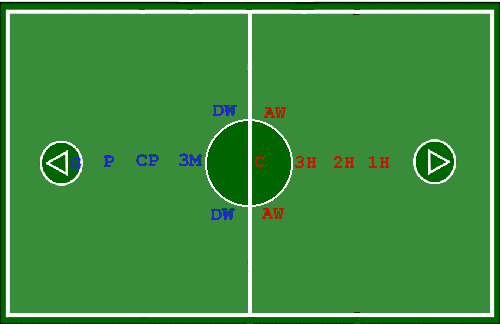|











| |
Lacrosse
101
MEN'S
LACROSSE (First Section)
WOMEN'S
LACROSSE (Second Section)
MEN'S
LACROSSE
How To Play Men's Lacrosse
FIELD POSITIONS
-
ATTACK: The attackman's responsibility is to score
goals. He generally restricts his play to the offensive end.
-
MIDFIELD: The midfielder's responsibility is to
cover the entire field playing both offense and defense.
-
DEFENSE: The defenseman's responsibility is to
defend the goal. He generally restricts his play to the defensive end of
the field.
-
GOAL: The goalie's responsibility is to protect
the goal and stop the opposing team from scoring.
RULES
Men's lacrosse is a contact game played by ten players: a goalkeeper, three
defensemen, three midfielders and three attackmen. The object of the game is
to shoot the ball into the opponent's goal. The team scoring the most goals
wins.
-
Each team must keep at least four players,
including the goalie, in its defensive half of the field and three in
its offensive half Three players (midfielders) may roam the entire
field.
-
Generally, high school games are 48 minutes long,
with 12 minute quarters. Each team is given a two minute break between
the first and second quarters, and the third and fourth quarters.
Halftime is ten minutes long.
-
Teams change sides between periods. Each team is
permitted two timeouts each half. The team winning the coin toss chooses
the end of the field it wants to defend first.
-
Men's lacrosse begins with a face-off. The ball is
placed between the sticks of two squatting players at the center of the
field. The official blows the whistle to begin play. Each face-off
player tries to control the ball. The players in the wing areas can
release; the other players must wait until one player has gained
possession of the ball or the ball has crossed the goal line.
-
Center face-offs are also used after a goal and at
the start of each quarter.
-
Players may run with the ball in the crosse, pass
and catch the ball. Only the goalkeeper may touch the ball with his
hands.
-
A player may gain possession of the ball by
dislodging it from an opponent's crosse with a stick check, which
includes the controlled poking and slapping of the stick and gloved
hands of the player in possession of the ball.
-
Body checking is permitted if the opponent has the
ball. However, all contact must occur from the front or side, above the
waist and below the shoulders. An opponent's crosse may also be stick
checked if it is within five yards of a loose ball or ball in the air.
-
If the ball or a player in possession of the ball
goes out of bounds, the other team is awarded possession of the ball. If
the ball goes out of bounds after an unsuccessful shot on goal, the
player nearest to the ball when and where it goes out of bounds is
awarded possession.
-
An attacking player cannot enter the crease around
the goal, but may reach in with his stick to scoop a loose ball.
PERSONAL FOULS
The penalty for a personal foul is a one to three
minute suspension from play and possession to the team that was fouled.
Players with five personal fouls are ejected from the game.
-
SLASHING: Occurs when a player's stick contacts an
opponent in any area other than the stick or gloved hand on the stick.
-
TRlPPlNG: Occurs when a player obstructs his
opponent at or below the waist with the crosse. hands. arms. feet or
legs.
-
CROSS CHECKING: Occurs when a player uses the
handle of his crosse to make contact with an opponent.
-
UNSPORTSMANLIKE CONDUCT: Occurs when any player or
coach commits an act which is considered unsportsmanlike by an official,
including taunting. obscene language or gestures. and arguing.
-
UNNECESSARY ROUGHNESS: Occurs when a player
strikes an opponent with his stick or body using excessive or violent
force.
-
ILLEGAL CROSSE: Occurs when a player uses a crosse
that does not conform to required specifications. A crosse may be found
illegal if the pocket is too deep or if the crosse was altered to gain
an advantage.
-
ILLEGAL BODY CHECKING: Occurs when any of the
following actions take place: (a) body checking of an opponent who is
not in possession of the ball or within five yards of a loose ball: (b)
avoidable body check of an opponent alter he has passed or shot the
ball; (c) body checking of an opponent from the rear or at or below the
waist; (d) body checking of an opponent by a player in which contact is
made above the shoulders of the opponent. A body check must be below the
neck, and both hands of the player applying the body check must remain
in contact with his crosse.
-
ILLEGAL GLOVES: Occurs when a player uses gloves
that do not conform to required specifications. A glove will be found
illegal if the fingers and palms are cut out of the gloves, or if the
glove has been altered in a way that compromises its protective features
.
TECHNICAL FOULS
The penalty for a technical foul is a thirty second
suspension if a team is in possession of the ball when the foul is
committed. or possession of the ball to the team that was fouled if there
was no possession when the foul was committed.
-
HOLDING: Occurs when a player impedes the movement
of an opponent or an opponent's crosse.
-
INTERFERENCE: Occurs when a player interferes in
any manner with the free movement of an opponent, except when that
opponent has possession of the ball, the ball is in flight and within
five yards of the players, or both players are within five yards of a
loose ball.
-
OFF SIDES: Occurs when a team does not have at
least four players on its defensive side of the midfield line or at
least three players on its offensive side of the midfield line.
-
PUSHING: Occurs when a player thrusts or shoves a
player from behind.
-
SCREENING: Occurs illegally when an offensive
player moves into and makes contact with a defensive player with the
purpose of blocking him from the man he is defending.
-
STALLING: Occurs when a team intentionally holds
the ball. without conducting normal offensive play, with the intent of
running times off the clock.
-
WARDING OFF: Occurs when a player in possession of
the ball uses his free hand or arm to hold, push or control the
direction of an opponent's stick check.
LACROSSE FAQ
-
What is the object of lacrosse?
-
How does the game begin?
-
What is a face off?
-
A face off consists of the two center players
at the mid-field line crouching down and placing their sticks on the
ground so that the heads of the sticks have their backs to each
other. The official then places the ball on the ground between the
heads of the sticks, steps back and blows a whistle which signals to
the players they can fight for possession of the ball.
-
When are face offs used?
-
How many men are there on a lacrosse team?
-
How many men are there on the field for one team?
-
There are ten men consisting of one
goaltender, three defense men, three mid-fielders, and three attack
men.
-
What are the goaltender's special privileges?
-
What is defined as "in the crease area"?
-
How long can a goaltender stay in the crease with
the ball?
The LACROSSE FIELD

-
What is the mid-field line?
-
What are the wing areas?
-
What is the crease area?
-
What is the one exception that allows an offensive
player to enter the crease area?
-
What are the restraining areas?
-
How big is a lacrosse goal?
WOMEN'S
LACROSSE
How To Play Women's Lacrosse
-
A game begins when the two centers from each team
"draw" at the center of the field: a ball is placed between their two
sticks pressed together back-to-back. When the umpire calls "draw," the
centers attempt to control the ball when they push the ball up and out
of the circle -- the area around the face-off. (Think of the tip-off in
basketball.)
-
Then, the players around the circle -- usually the
attack wings, defense wings, 3rd Homes and 3rd Men from both teams --
sprint for the descending ball. Once control is attained by a team, it
works pretty much like some other sports: players run and pass the ball
to push it down field toward the goal.
-
Cradling is the method by which a player holds the
ball in the stick's pocket. Unlike men's lacrosse, women's sticks may
not have a deep pocket in which to hold the ball securely; a player
"cradles" the ball to keep it in the pocket. Cradling uses centripetal
force -- the force generated by moving something in a circle -- to press
the ball into the back of the pocket. (You can feel centripetal force at
the amusement park when a ride spins and pushes you out from the axis
around which you're turning.)
-
To learn to cradle, hold a pen or pencil with your
right fist around the top, and the left hand around the bottom (for
lefties, reverse it -- left hand on top.) Now bring both fists and the
pen to your right shoulder, keeping the pen vertical. Then bring it to
your left shoulder, keeping the pen vertical. Although you won't be able
to see the centripetal force at work using this example, very basically,
this is cradling.
-
When a player has an opening to the goal, she
shoots the ball by pushing the head of the stick forward, and pulling
the the shaft back. The shots can be extremely accurate and fast.
-
Passing is the fastest way to get the ball down
field, but it can also be one of the hardest things to do. Releasing the
ball with speed and accuracy can take LOTS of practice to make it
effective.
-
Passing is done in the same manner as shooting,
but catching the pass is often the hardest part. Not only does the ball
have to land in your stick, but you must also learn to put the catch
immediately into a cradle to gain control of the ball and prevent
yourself from being checked.
-
Checking is the technique in which a series of
short, sharp, controlled strikes to an opponent's stick is used to force
a player carrying the ball to drop it.
-
A player can check the head or shaft of the stick,
or body check.
-
Body checking sounds like a player would strike an
opponent's body, but it's actually accomplished when a defender sticks
close to her opponent in an effort to intimidate the player into
dropping the ball, or changing the opponent's path towards the goal.
-
There are 12 players on each team, including the
goalie.
Attack positions are: Center, Right Attack Wing, Left Attack Wing, 3rd
Home, 2nd Home, 1st Home
Defense positions are: Right Defense Wing, Left Defense Wing, 3rd Man,
Cover Point, Point, Goalie
-
Player Equipment: Stick, Cleats, Mouthguard,
Numbered shirt and kilt or shorts, and Padded Gloves (optional)
Goalie Equipment: Helmet with face-mask and throat protector, Padded
Gloves, Arm Pads, Chest Pad, Leg Pads, and goalie stick
-
The Field: There are four types of demarcation
lines around the goal: the circle, the arc, the fan, and hash marks. The
circle envelopes the goal cage and no one but the goalie is allowed in
the circle. The goal is guarded by a single goalie and measures about 6
feet by 6 feet. The field has no boundaries, but is usually enclosed by
existing borders, such a trees, a track or fences.

-
Referees: Use a whistle to denote a foul. Can
confer a yellow and/or red card on a player who committed a severe foul,
or who has repeatedly committed the same foul. When a player receives a
yellow card, she is warned that she is in danger of being ejected from
the game. If a player is given a red card, she is ejected. When a foul
is committed, the umpire will blow the whistle and determine whether the
foul is major or minor. Penalties are more severe for major fouls than
minor ones. If a player commits a minor foul, she must forfeit
possession of the ball (if she has it) and move four meters either to
the side or in front of the player whom she fouled. If a player commits
a major foul, she must forfeit possession of the ball (if she has it)
and move four meters behind the player whom she fouled. umpires can
require a longer distance if the foul was reckless.
Women's
Rules
-
Before the game begins, the umpires checks every
stick (except the goalie's) for legality. The most common illegality in
a stick is that its pocket is too deep. The strings at the bottom of the
stick's head can be pulled to tighten the pocket.
-
If a player commits a foul, the umpire blows the
whistle and play stops. The player fouled wins or retains the ball,
while the player who fouled her is moved several yards behind or to the
side of the player she fouled.
-
If a major foul is committed in the arc by the
defense, the umpire blows the whistle, and a "free shot" on goal is
taken by the player fouled. All of the defense players are required to
clear the arc to the border closest to which they were standing when the
whistle blew.
-
The attack player who was fouled takes her place
at the hash mark closest to which she was standing when she was fouled.
The defense must move away at least four meters from the fouled player.
When the umpire blows the whistle again, the player can take a shot on
goal or pass while the defense moves in.
-
There are no boundaries to the field, but if a
ball enters an area that is dangerous, unplayable or not clearly visible
to the umpire, the player who retains it or is closest to it (if the
ball has been grounded), at the umpire's whistle wins it. The player
then waits for the second whistle to begin play again, either by running
with or passing the ball.
-
When the umpire blows the whistle because a foul
has occurred, or the ball has gone "out of bounds" all players must stop
and check all forward movement. Play resumes and the players can move
when the umpire blows the whistle again.
-
Checking -- the method by which a player knocks
the ball from another's stick -- is prohibited when it is: directed
toward the face; uncontrolled; holding down the other's stick,or when
the checker's stick is too close to the head or face.
-
Defensmen may not remain in the arc without
guarding another player.
-
When the ball is grounded, covering it with the
back of a stick's net, and preventing play by another player is
prohibited.
-
No players, other than the goalie, may enter the
circle around the goal cage
-
When a foul occurs, the player who was fouled is
allowed a free shot at the goal, with the defense pushed to the
perimeter around the arc.
|